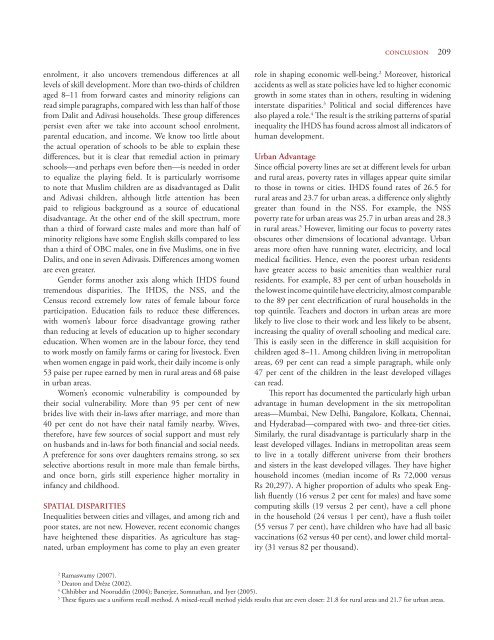Human Development in India - NCAER
Human Development in India - NCAER
Human Development in India - NCAER
You also want an ePaper? Increase the reach of your titles
YUMPU automatically turns print PDFs into web optimized ePapers that Google loves.
conclusion 209enrolment, it also uncovers tremendous differences at alllevels of skill development. More than two-thirds of childrenaged 8–11 from forward castes and m<strong>in</strong>ority religions canread simple paragraphs, compared with less than half of thosefrom Dalit and Adivasi households. These group differencespersist even after we take <strong>in</strong>to account school enrolment,parental education, and <strong>in</strong>come. We know too little aboutthe actual operation of schools to be able to expla<strong>in</strong> thesedifferences, but it is clear that remedial action <strong>in</strong> primaryschools—and perhaps even before then—is needed <strong>in</strong> orderto equalize the play<strong>in</strong>g field. It is particularly worrisometo note that Muslim children are as disadvantaged as Dalitand Adivasi children, although little attention has beenpaid to religious background as a source of educationaldisadvantage. At the other end of the skill spectrum, morethan a third of forward caste males and more than half ofm<strong>in</strong>ority religions have some English skills compared to lessthan a third of OBC males, one <strong>in</strong> five Muslims, one <strong>in</strong> fiveDalits, and one <strong>in</strong> seven Adivasis. Differences among womenare even greater.Gender forms another axis along which IHDS foundtremendous disparities. The IHDS, the NSS, and theCensus record extremely low rates of female labour forceparticipation. Education fails to reduce these differences,with women’s labour force disadvantage grow<strong>in</strong>g ratherthan reduc<strong>in</strong>g at levels of education up to higher secondaryeducation. When women are <strong>in</strong> the labour force, they tendto work mostly on family farms or car<strong>in</strong>g for livestock. Evenwhen women engage <strong>in</strong> paid work, their daily <strong>in</strong>come is only53 paise per rupee earned by men <strong>in</strong> rural areas and 68 paise<strong>in</strong> urban areas.Women’s economic vulnerability is compounded bytheir social vulnerability. More than 95 per cent of newbrides live with their <strong>in</strong>-laws after marriage, and more than40 per cent do not have their natal family nearby. Wives,therefore, have few sources of social support and must relyon husbands and <strong>in</strong>-laws for both f<strong>in</strong>ancial and social needs.A preference for sons over daughters rema<strong>in</strong>s strong, so sexselective abortions result <strong>in</strong> more male than female births,and once born, girls still experience higher mortality <strong>in</strong><strong>in</strong>fancy and childhood.SPATIAL DISPARITIESInequalities between cities and villages, and among rich andpoor states, are not new. However, recent economic changeshave heightened these disparities. As agriculture has stagnated,urban employment has come to play an even greaterrole <strong>in</strong> shap<strong>in</strong>g economic well-be<strong>in</strong>g. 2 Moreover, historicalaccidents as well as state policies have led to higher economicgrowth <strong>in</strong> some states than <strong>in</strong> others, result<strong>in</strong>g <strong>in</strong> widen<strong>in</strong>g<strong>in</strong>terstate disparities. 3 Political and social differences havealso played a role. 4 The result is the strik<strong>in</strong>g patterns of spatial<strong>in</strong>equality the IHDS has found across almost all <strong>in</strong>dicators ofhuman development.Urban AdvantageS<strong>in</strong>ce official poverty l<strong>in</strong>es are set at different levels for urbanand rural areas, poverty rates <strong>in</strong> villages appear quite similarto those <strong>in</strong> towns or cities. IHDS found rates of 26.5 forrural areas and 23.7 for urban areas, a difference only slightlygreater than found <strong>in</strong> the NSS. For example, the NSSpoverty rate for urban areas was 25.7 <strong>in</strong> urban areas and 28.3<strong>in</strong> rural areas. 5 However, limit<strong>in</strong>g our focus to poverty ratesobscures other dimensions of locational advantage. Urbanareas more often have runn<strong>in</strong>g water, electricity, and localmedical facilities. Hence, even the poorest urban residentshave greater access to basic amenities than wealthier ruralresidents. For example, 83 per cent of urban households <strong>in</strong>the lowest <strong>in</strong>come qu<strong>in</strong>tile have electricity, almost comparableto the 89 per cent electrification of rural households <strong>in</strong> thetop qu<strong>in</strong>tile. Teachers and doctors <strong>in</strong> urban areas are morelikely to live close to their work and less likely to be absent,<strong>in</strong>creas<strong>in</strong>g the quality of overall school<strong>in</strong>g and medical care.This is easily seen <strong>in</strong> the difference <strong>in</strong> skill acquisition forchildren aged 8–11. Among children liv<strong>in</strong>g <strong>in</strong> metropolitanareas, 69 per cent can read a simple paragraph, while only47 per cent of the children <strong>in</strong> the least developed villagescan read.This report has documented the particularly high urbanadvantage <strong>in</strong> human development <strong>in</strong> the six metropolitanareas—Mumbai, New Delhi, Bangalore, Kolkata, Chennai,and Hyderabad—compared with two- and three-tier cities.Similarly, the rural disadvantage is particularly sharp <strong>in</strong> theleast developed villages. <strong>India</strong>ns <strong>in</strong> metropolitan areas seemto live <strong>in</strong> a totally different universe from their brothersand sisters <strong>in</strong> the least developed villages. They have higherhousehold <strong>in</strong>comes (median <strong>in</strong>come of Rs 72,000 versusRs 20,297). A higher proportion of adults who speak Englishfluently (16 versus 2 per cent for males) and have somecomput<strong>in</strong>g skills (19 versus 2 per cent), have a cell phone<strong>in</strong> the household (24 versus 1 per cent), have a flush toilet(55 versus 7 per cent), have children who have had all basicvacc<strong>in</strong>ations (62 versus 40 per cent), and lower child mortality(31 versus 82 per thousand).2Ramaswamy (2007).3Deaton and Drèze (2002).4Chhibber and Noorudd<strong>in</strong> (2004); Banerjee, Somnathan, and Iyer (2005).5These figures use a uniform recall method. A mixed-recall method yields results that are even closer: 21.8 for rural areas and 21.7 for urban areas.















